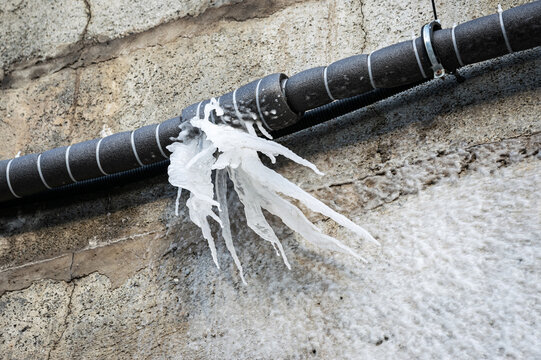Essential Advice for Avoiding Frozen Plumbing in Cold Weather Conditions
Essential Advice for Avoiding Frozen Plumbing in Cold Weather Conditions
Blog Article
Just how do you really feel in regards to 6 Ways to Prevent Frozen Pipes?

Winter can damage your plumbing, especially by freezing pipes. Below's how to stop it from occurring and what to do if it does.
Intro
As temperatures decline, the threat of icy pipelines boosts, possibly leading to expensive repairs and water damage. Understanding exactly how to prevent frozen pipes is vital for property owners in cold environments.
Avoidance Tips
Protecting susceptible pipelines
Wrap pipes in insulation sleeves or make use of warm tape to shield them from freezing temperatures. Concentrate on pipes in unheated or outside locations of the home.
Heating methods
Maintain indoor rooms sufficiently warmed, especially areas with plumbing. Open up closet doors to allow warm air to distribute around pipelines under sinks.
Just how to recognize icy pipes
Search for decreased water flow from faucets, unusual odors or noises from pipes, and noticeable frost on subjected pipes.
Long-Term Solutions
Structural modifications
Think about rerouting pipes away from exterior wall surfaces or unheated locations. Include additional insulation to attic rooms, basements, and crawl spaces.
Upgrading insulation
Invest in high-grade insulation for pipes, attic rooms, and walls. Appropriate insulation aids keep consistent temperature levels and minimizes the risk of frozen pipelines.
Safeguarding Exterior Plumbing
Yard hose pipes and exterior faucets
Detach and drain pipes garden pipes prior to winter season. Mount frost-proof faucets or cover exterior faucets with shielded caps.
Recognizing Icy Pipelines
What causes pipelines to ice up?
Pipes ice up when revealed to temperatures below 32 ° F (0 ° C) for prolonged durations. As water inside the pipelines ices up, it increases, taxing the pipe walls and possibly causing them to burst.
Risks and damages
Frozen pipelines can lead to supply of water disruptions, residential property damages, and costly repair services. Ruptured pipelines can flood homes and cause extensive architectural damages.
Indications of Frozen Pipes
Recognizing icy pipes early can stop them from rupturing.
What to Do If Your Pipelines Freeze
Immediate actions to take
If you believe frozen pipes, maintain faucets open up to ease pressure as the ice melts. Use a hairdryer or towels taken in hot water to thaw pipelines slowly.
Verdict
Avoiding icy pipes requires aggressive steps and fast responses. By understanding the causes, indicators, and preventive measures, home owners can protect their pipes throughout cold weather.
6 Proven Ways to Prevent Frozen Pipes and Protect Your Home
Disconnect and Drain Garden Hoses
Before winter arrives, start by disconnecting your garden hoses and draining any remaining water. Close the shut-off valves that supply outdoor hose bibs and leave the outdoor faucet open to allow any residual water to drain. For extra protection, consider using faucet covers throughout the colder months. It’s also important to drain water from any sprinkler supply lines following the manufacturer’s directions.
Insulate Exposed Pipes
Insulating your pipes is an effective way to prevent freezing. Pipe insulation is readily available at home improvement stores and is relatively inexpensive. Pay close attention to pipes in unheated areas such as the attic, basement, crawl spaces, or garage. Apply foam insulation generously to create a buffer against the cold. You can also wrap your pipes in heat tape or thermostat-controlled heat cables for added warmth.
Seal Air Leaks
Inspect your home for any cracks or openings that could let in cold air. Seal any holes around the piping in interior or exterior walls, as well as the sill plates where your home rests on its foundation. Additionally, make sure to keep your garage door closed unless you’re entering or exiting. Leaving it open creates a significant air leak that can lead to frozen pipes.
Allow Warm Air Circulation
During cold snaps, it’s essential to allow warm air to circulate evenly throughout your home. Leave interior doors ajar to promote better airflow. Open kitchen and bathroom cabinets to help distribute heat consistently around the rooms. If you have small children or pets, be sure to remove any household chemicals or potentially harmful cleaners from open cabinets for safety.
Let Faucets Drip
A small trickle of water can make a big difference in preventing ice formation inside your pipes. When temperatures drop significantly, start a drip of water from all faucets served by exposed pipes. This continuous flow helps prevent the water from freezing. Additionally, running a few faucets slightly can relieve pressure inside the pipes, reducing the chances of a rupture if the water inside does freeze.
https://choateshvac.com/6-proven-ways-to-prevent-frozen-pipes-and-protect-your-home/

Do you like reading about Preventing and dealing with frozen pipes? Try to leave feedback further down. We'd be glad to hear your reactions about this piece. In hopes that you visit us again in the future. Sharing is caring. Helping people is fun. We appreciate reading our article about How to Prevent Your Pipes From Freezing.
Book Inspection Report this page